The
Rise of the Zombies
|
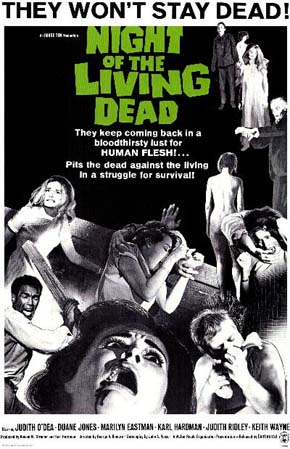
George
Romero's 1968 low-budget, film classic Night of the
Living Dead was a turning point for zombies.
|
Vampires have been popular figures in horror since
Bram Stoker wrote Dracula in 1897. The root of werewolf
folklore can be traced all the way back to the ancient Greeks.
Zombies, in their current form, however, have only shuffled
their stiff-legged corpses onto the silver screen in the last
few decades. Where did the zombie myth come from and why are
they now so popular?
Zombie
History
The term itself, zombie, actually goes
back many centuries before Hollywood appropriated it for horror
films. The root of the word comes from the language of Kikongo
spoken by the Bakongo and Bandundu people living in the African
Congo. Linguists think the expression comes from the related
term nzambi which means "god." The religion in this region
of the world was Vodun. When captured and forced into
slavery in the New World, West Africans brought their religion
with them. There it was mixed with other African traditions
and Christianity. The result was the folk religion of Vodou
(sometimes spelled Voodoo). Vodou eventually became a
major faith on the island of Hispaniola and in the two countries
that share that land, the Dominican Republic and Haiti.
In Vodou a zombie is a person who has died and
then been raised from the dead by bokor (a Vodou priest).
The zombie's soul is removed and he is rendered into an almost
robotic state following the orders of his bokor without question
or self-awareness. Often the bokor will put the zombie to work
as a form of free labor.
As you might guess, this kind of nightmare scenario
made for some great horror stories. The concept was introduced
to western culture in 1929 by W.B. Seabrook in his travelogue
to Haiti called The Magic Island. Seabrook, a former
editor of the Augusta Chronicle in Georgia, was an odd
figure fascinated with the occult, Satanism and folk religions.
While traveling in West Africa he claimed to have tasted human
flesh reporting that "the roast, from which I cut and ate a
central slice, was tender, and in color, texture, smell as well
as taste, strengthened my certainty that of all the meats we
habitually know, veal is the one meat to which this meat is
accurately comparable."
|
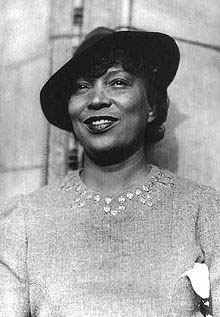
In
1936 anthropologist and writer Zora Neale Hurston visited
Haiti and interviewed a woman she thought might be a zombie.
|
Shortly after Seabrook's book came out the ideas
within it were turned into the first zombie movie: 1933's White
Zombie, starring Bela Lugosi. In this film Lugosi is the
evil Haitian Vodou master who enslaves a young, pretty girl,
Madge Bellamy, as a zombie until she is rescued by her fiancée.
Critics bashed the movie for poor acting and an
over-the-top storyline. However, Lugosi was well-known for his
roll as Dracula in the 1930 Universal picture of the same name,
and his fame no doubt assisted the White Zombie at the
box office. It did well enough to warrant a 1936 sequel, Revolt
of the Zombies. After that a number of other zombie films
appeared including The Ghost Breakers (1940), King
of the Zombies (1941), I Walked with a Zombie (1943),
and The Plague of the Zombies (1966).
Science
and the Zombie
Eight years after Seabrook's visit to Haiti, author,
folklorist and anthropologist, Zora Neale Hurston, visited the
country and while researching Vodou folklore met a woman named
Felicia Felix-Mentor. Records showed that Felix-Mentor had died
almost 30 years earlier in 1907, yet she was found wandering
the streets in 1936. After making her way to her father's house
(which by that time was owned by her brother) she was identified
by her relatives. Doctors examined her and reported that "her
occasional outbursts of laughter were devoid of emotion, and
very frequently she spoke of herself in either the first or
the third person without any sense of discrimination. She had
lost all sense of time and was quite indifferent to the world
of things around her." Hurston interviewed Felix-Mentor at length
and believed that she had been made into a zombie. Hurston didn't
think that bokors could actually raise people from the dead,
but suspected they drugged them with some unknown potion that
gave the victims the appearance of having died. The priests
then raided the cemetery, retrieved the person, and kept them
in a zombie state using other powerful drugs. Hurston pointed
out that in Haiti bodies are interned above ground and without
embalming, making the chances of a successful "resurrection"
a realistic possibility.
|
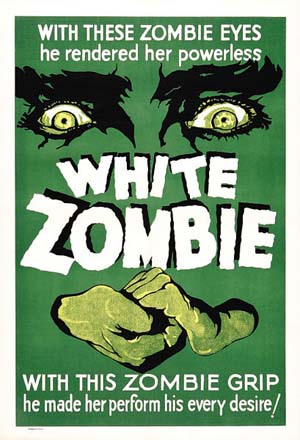
The
poster from 1933's White Zombie.
|
Another scientist took a look at zombies in 1982
when Wade Davis, a Harvard ethnobotanist, visited Haiti. According
to his investigations bokors used tetrodotoxin (a neurotoxin
found in the flesh of the pufferfish) to simulate death in the
victim. When the victims awakened the priest would put them
into a psychotic state by giving them a drug like datura.
Wade contended that the person's culturally-learned beliefs
- that they had died and were now zombies - helped reinforce
their obedient behavior.
He supported his claims by citing the case of
Clairvius Narcisse, a Haitian man who was recorded to have died
in 1962, but was found alive several years later. According
to Narcisse, he had quarreled with his brother, who then hired
a bokor to poison Narcisse with the pufferfish toxin (introducing
it through scratches in his arm). A funeral was held for Narcisse,
but his body was recovered later by the bokor, who used drugs
to make Narcisse into a zombie so he could work on the priest's
plantation. When the bokor died, the drugs eventually wore off
and Narcisse returned to his family.
Davis had his skeptics, but that didn't stop him
from writing two books on the subject: The Serpent
and the Rainbow in 1985 and Passage of Darkness:
The Ethnobiology of the Haitian Zombie in 1988. The
Serpent and the Rainbow was made into a zombie movie in
1988. Directed by Wes Craven, it starred Bill Pullman as the
scientist who tracks down the macabre truth.
Night
of the Living Dead
It had been almost twenty years earlier, however,
that the history of the zombie film had made an unexpected turn.
Up to that point zombies were more victims than perpetrators.
People feared being turned into zombies, not being eaten by
them.
In the mid-1960's a young TV commercial director
named George Romero, along with some business partners, decided
to try their hand at making a low-budget horror film. Several
scripts were written before Romero came up with the idea of
reanimated human corpses that had a hunger for human flesh.
Romero's inspiration came from Richard Matheson's 1954 book
I Am Legend. In the book a plague ravages the world,
turning those infected into vampires who attack the few remaining
individuals who are immune.
|
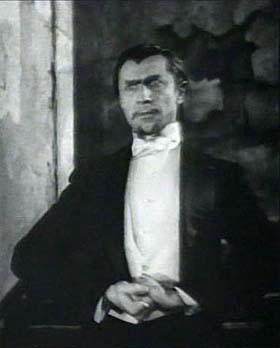
Bela
Lugosi as the Zombie Master in White Zombie.
|
I Am Legend had already been made into
a film, The Last Man on Earth, in 1964. (Later it would
be committed to celluloid again in 1971 as The Omega Man
with Charlton Heston and then again in 2007 as I Am Legend
with Will Smith). Since the idea of vampires had already been
taken, Romero needed to come up with his own monsters for the
movie. Instead of drinking blood, he decided to have them consume
flesh. He never referred to these resurrected monsters as zombies,
but used the term ghouls.
In fact, the roots of Romero's ghouls go back
not to Vodou, but probably owe more to writer H.P. Lovecraft
and his short story Herbert West - Reanimator. Lovecraft's
tale has a mad scientist who, like Frankenstein before him,
spends his time reanimating dead bodies. These critters, though,
have a taste for human flesh and the good doctor gets disemboweled
in the end by his cannibalistic creations.
In June of 1967 a handful of movie makers, led
by the then 27-year-old Romero, descended onto the small town
of Evans City, Pennsylvania, some 30 miles north of Pittsburgh,
to film the picture. The grainy, black and white, low-budget
production was originally called Night of the Flesh Eaters.
However, a last minute conflict with another film with a similar
title forced it to be released as Night of the Living Dead.
Romero's plot had a group of people trapped in
a farmhouse while across the east coast of America, freshly
dead corpses start rising from the grave, then attacking and
consuming the living. The mood of the film is unflinchingly
grim as one by one the members of the group are picked off and
eaten or are turned into ghouls themselves (including an 11-year-old
girl that snacks on her father). In the end there is only one
survivor of the night's carnage and he is killed when he is
mistakenly identified as a ghoul himself by authorities.
From
Tasteless Junk to Historical Significance
|
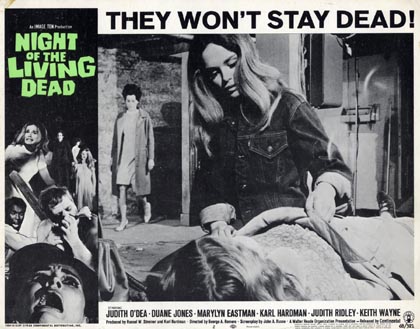
A
lobby card from Night of the Living Dead.
|
When it came out in 1968, the movie was heavily
criticized because of its explicit content. Variety labeled
Night of the Living Dead an "unrelieved orgy of sadism."
Even those that liked the film, such as critic Roger Ebert,
found the way it was often shown at Saturday afternoon matinées
filled with children, irresponsible. "I don't think the younger
kids really knew what hit them," Ebert said. "They were used
to going to movies, sure, and they'd seen some horror movies
before, sure, but this was something else."
Audiences ate it up, however, and eventually the
film was recognized by the Library of Congress as a film deemed
"culturally, historically or aesthetically significant." The
New York Times, whose critic had originally referred to
it as a "junk movie," later put the film on their list of the
Best 1000 Movies Ever. It spawned dozens of look-alikes
and Romero went on to do several sequels himself.
Its reputation grew as film analysts read deeper
meanings into the movie's prevalent slaughter. The little girl
eating her dad became a symbol of the breakdown of the patriarchal
nuclear family. Others found the movie a "grotesque echo of
the conflict then raging in Vietnam." Hints about America's
racial tensions were also found in the motion picture because
the sheriff that callously shoots the lone survivor is white
and the victim black.
The original film, which cost only $114,000, earned
$18 million internationally and might have made even more. Unfortunately
the distribution company, in changing the title at the last
minute, accidentally removed the copyright notification. Under
the law at the time this put the film immediately into the public
domain.
Zombies
as a Symbol
|
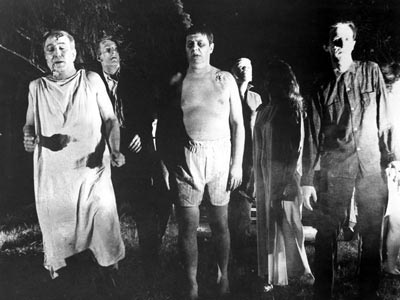
The
zombies are coming! The zombies are coming! From Night
of the Living Dead
|
The number of zombie films that followed Night
of the Living Dead are legion. Some are deadly serious,
like Romero's squeal, Dawn of the Dead (1978), though
many have a streak of humor, as in Zombieland (2009),
or are outright comedies like Shaun of the Dead (2004).
The zombie craze has infected filmmakers and audiences throughout
the world as Japan's Stacy: Attack of the Schoolgirl Zombies
(2001) and Cuba's Juan of the Dead (2012) testify.
Whatever the type of film they appear in it is
clear that these new flesh-eating ghouls have joined vampires
and werewolves in the modern myth of the paranormal. Why is
this new type of zombie so popular, when its predecessor, the
traditional zombie of Vodou only showed up in a handful of films
between 1933 and 1969?
Some people have suggested that zombies represent
the trials we face in modern life. Max Brooks, author of The
Zombie Survival Guide, writes, "You can't shoot the financial
meltdown in the head -- you can do that with a zombie... All
the other problems are too big. As much as Al Gore tries, you
can't picture global warming. You can't picture the meltdown
of our financial institutions. But you can picture a slouching
zombie coming down the street."
Like the invading aliens of the 50's once symbolized
the communist menace and vampires stood in for the AIDs threat
of the 80's and 90's, modern zombies are emblems of our contemporary
anxieties. Unlike others, though, these dangers arise close
to home due to our recent economic misfortunes. As Adam Baker
writes in the Huffington Post. "Zombies are us. Our friends,
neighbors and relatives. They are not a threat arrived from
overseas or outer space. They are our own communities turned
monstrous and hostile, folks we pass in the street recast as
deadly predators. Nightmare imagery of desolate streets, cannibal
hoards, barricaded homes under relentless assault, is our everyday
word viewed through the lens of economic desperation."
|
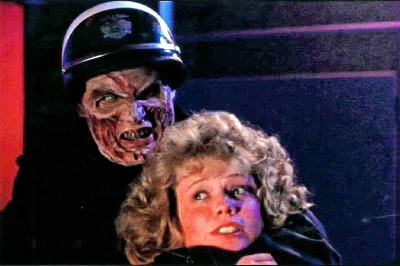
Actress
Kelli Maroney gets grabbed by a zombified cop in 1984's
Night of the Comet.
|
As with past crises, these films will hopefully
help us cope with these stressful times. In this age of social
upheaval - high unemployment and underwater mortgages - we look
to tales of survival to comfort us. If the kids in Night
of the Comet (1984) can outlast a zombie apocalypse and
the end of civilization, perhaps we can survive the real estate
implosion and our vanishing IRAs.

Copyright
2012 Lee Krystek. All Rights Reserved.